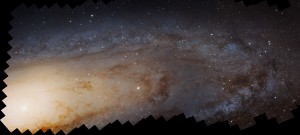Anyone who has used a digital camera and some editing software, will have tried to create a panorama by combining two or more photos together. It's a technique that can be easily accomplished – with a product like Photoshop – for half a dozen photos or so. The folks at NASA have been a little more ambitious. KitGuru stitches the facts together.
Launched into low Earth orbit back in 1990, Hubble has been pointing its 2.4 metre mirror at astronomic bodies for 25 years – and it continues to amaze. Especially when you consider that its main lens was faulty and could not function properly until the 11,000Kg telescope had been orbiting the Earth for 3 years.
There was a chance that the programme would be canned around 2009, but one final maintenance mission was launched and there are now hopes that Hubble will continue to capture the universe through to 2020.
That brings us to the Panchromatic Hubble Andromeda Treasury project – which spans many years – and involves the capture and integration of more than 7,300 individual images into a single shot of our nearest galactic neighbour.
The shots themselves were taken from July 2010 through to October 2013 and have, finally, been brought together with fidelity.
The result is a single shot that shows the combined beauty of around 117 million stars. Even so, this ‘three year compilation' is less than half of everything in the area.
Technically, the images were shot in monochrome, but Hubble is a smart device and can use multiple filters to capture a specific part of the spectrum, from infrared to ultraviolet – which are then combined using special techniques to create false-colour final images.
Hubble collects data on solid state devices that were fitted, in space, between 1997 and 1999 – and the telescope sends around 120GB of data back to Earth each week.
Below is a small version of the final version – click on it to get a 1920 ‘HD' version or use this link for the full 10,000 pixel version. For more info, you can visit the PHAT mission page here.

KitGuru says: Should we spend all our time and money getting to Mars – or is there more to be learned through instruments like Hubble?
Let us know how you see space exploration over on Facebook.
 KitGuru KitGuru.net – Tech News | Hardware News | Hardware Reviews | IOS | Mobile | Gaming | Graphics Cards
KitGuru KitGuru.net – Tech News | Hardware News | Hardware Reviews | IOS | Mobile | Gaming | Graphics Cards



throw our rubbish in space, if it doesn’t come back, then well we are alone in the universe, at least that’s one indication of how things can be done, a bit stupid but you never know it’s space after all and a whole lot of it